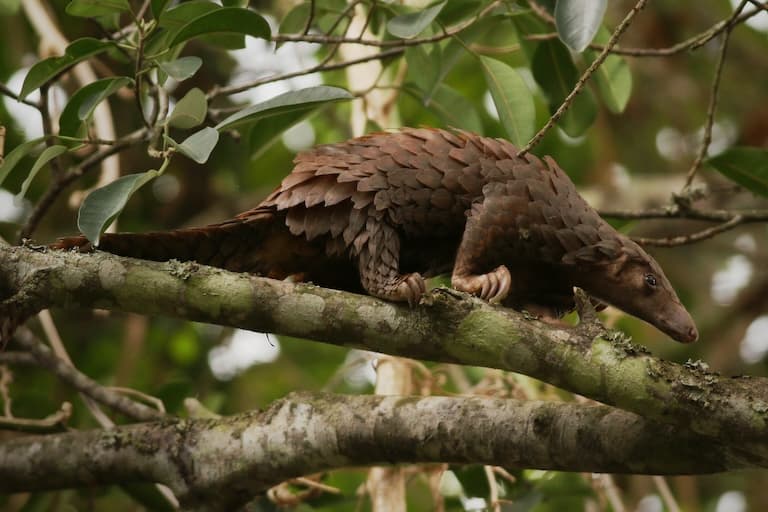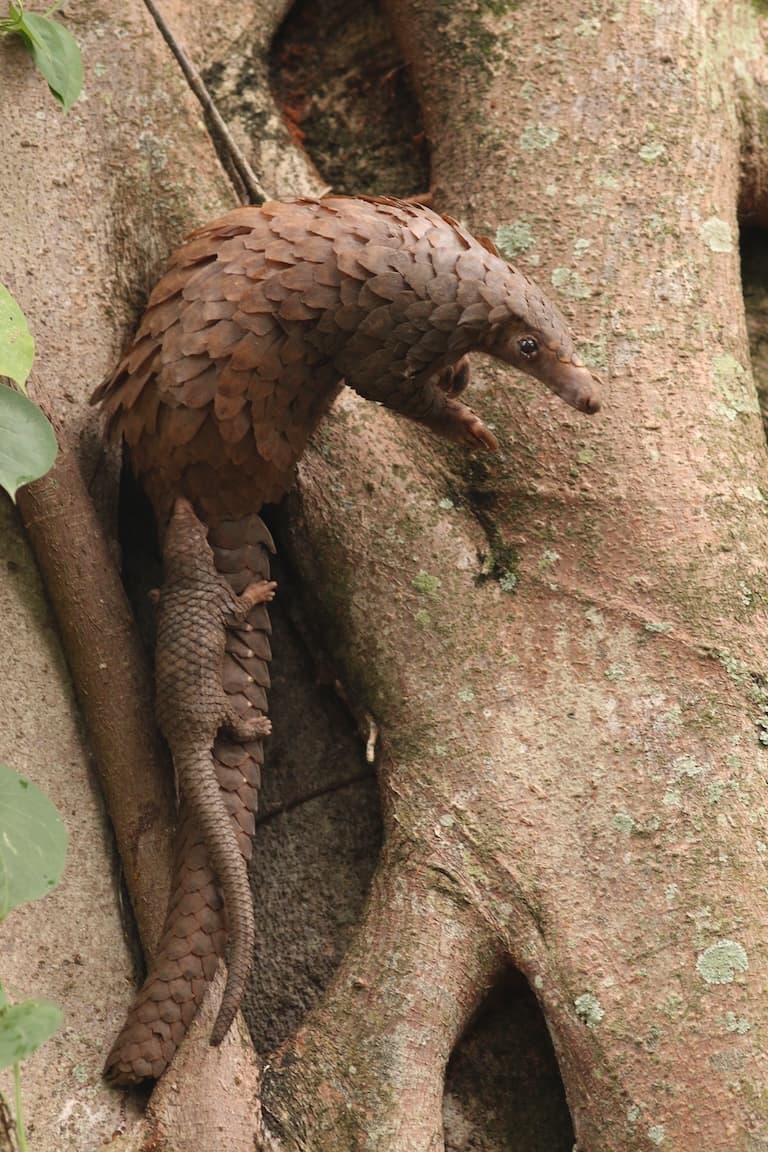Tree Pangolin Profile
Across the forests of equatorial Africa, there’s a very special animal group consisting of two genera and four species of bizarre, scaled mammals. These animals are so unique that it’s perhaps not surprising they have become almost legendary to local peoples, and, sadly people from much farther afield who really should know better.
Pangolins are the most trafficked mammal on Earth, and the very rare and arboreal white-bellied, or tree pangolin is one example of an animal facing threats from humanity on almost every front.

Tree Pangolin Facts Overview
| Habitat: | Lowland rainforest, mixed savanna/forest ecosystems |
| Location: | Equatorial Africa as far East as Kenya and Tanzania |
| Lifespan: | 20 in the wild, up to 13 in captivity |
| Size: | Up to 43 cm (17 in) with a 62 cm (24 in) tail |
| Weight: | 1.5 kg (3.3 lb) |
| Colour: | Dark brown to brownish yellow |
| Diet: | Insects, mostly termite |
| Predators: | Mostly humans, also lions, leopards |
| Top Speed: | Slow |
| No. of Species: | 1 |
| Conservation Status: | Endangered (IUCN) |
Tree pangolins are part of one of the most unusual animal groups on Earth. They’re members of only one of three genera of pangolins in the family Manidae, and one of only four species found on the African continent.
They’re not only strange in appearance, but also have some curious genetic and behavioural quirks, and while you’d think an animal as special as this would be revered and protected, it’s being relentlessly poached, hunted, eaten, sold and ground up for medicine that doesn’t even work.
Interesting Tree Pangolin Facts
1. They’re Manids
The family Manidae is the only remaining group of pangolins left and one of several families that once filled the order Pholidota.
This order was once considered to be the close relative of Xenarthra, the order of sloths, armadillos and anteaters, and you can see why.
Pangolins are armoured like the armadillos, toothless like the anteaters and (at least in the tree pangolins) arboreal like the sloths. They’re also weird, as is tradition among the Xenarthrans.
But recent studies have identified a closer link to modern Carnivorans, animals like otters, cats, and dogs, with whom they appear to have diverged around 80 million years ago, during the Cretaceous period.
The other pangolin families went extinct from Europe and the Americas, and the African and Asian pangolins diverged from a common ancestor around 40 million years ago. Today there are four African species in two genera and four species in a single genus in Asia.
Of the African species, two form a genus of arboreal pangolins, but for some reason, only one, the white-belied pangolin, is known as the “Tree pangolin”.

2. They don’t leave a lot of fossils
One reason these strange animals aren’t well understood is because they have no teeth. Teeth are some of the most unique features in a species, and some of the most reliably hard and likely to fossilise. This gives palaeontologists a fantastic tool for identifying ancient species.
But pangolins are toothless anteaters, so that’s out. And to make matters worse, the order may have been sparsely populated to begin with.
It is now one of the least populated mammalian orders in the world, and may not have been much better off in the past.
Further, pangolins themselves are solitary and occupy large home ranges, away from other pangolins, so they’re naturally low-density critters. Thankfully, genetic research is moving in leaps and bounds, and researchers are piecing their histories together that way.
And pangolins have plenty of genetics for testing.
3. They have a lot of chromosomes
A very recent paper on pangolin DNA has brought forth a surprise discovery. The white-bellied, or tree pangolin, has 114 chromosomes, more than any other mammal investigated except the bamboo rat, who has two more pairs.
To put this into perspective, humans have 23 pairs or 46 chromosomes, and most other pangolins have around 40 total.
But to make matters weirder, male pangolins have one fewer than females, at 113, while in most species, the sexes share the same number.
This is critical information for conservationists, who are desperately trying to figure out how to save the species, along with all other pangolin species who are either Endangered or Critically Endangered.
Having so many chromosomes may be great news for this species, as it ties into what’s called “Hybrid vigour”, in which the offspring are likely fitter and healthier than either of their parents.
Unfortunately, no quantity of chromosomes can defend against relentless human stupidity. 1 2
4. They’re not medicinal
The gradual discrediting of science by mainstream media has been a force of evil that is rarely called out.
Climate change, pandemics, GMOs and renewable energy are but a few recent subjects of suppression and manipulation by the powers they threaten (older ones being cigarettes, leaded petrol and the ozone layer); likewise, industries like homoeopathy and “alternative medicine” fill a niche for people who have been told that modern science can’t be trusted and take advantage of a dwindling scientific literacy.
This is why, while there are plenty of safe and affordable pharmaceutical treatments for rheumatism, swellings, and cysts, there is still a huge demand for something else to do it. Something natural. And pangolin scales, while they have no medicinal properties, are being touted as that solution.
The result is a small group of mammals like no other on Earth, being driven rapidly to extinction for absolutely no benefit other than to the pockets of those who sell their scales.
This be a tragedy even if the medicine worked, but the fact that it doesn’t is a testament to the egocentric approach of humans to nature. Pangolins are now the most trafficked mammal and are at imminent risk of extinction.
Ironically, “medicines” derived from wild animals bring a risk of global pandemics like Ebola and COVID-19. 3
5. They don’t do well in captivity
Many species whose habitats are gone or going, find refuge in captivity, and through responsible breeding programs can sustain the genetic health of the species in an attempt to one day replenish their populations in the wild.
But pangolins aren’t built for captivity, which is why you’re not likely to have ever seen one in a zoo. Very few institutions have successfully kept a pangolin, let alone bred one; they just stop eating when taken from the wild.
This is another reason the pangolin conservation movement is such a desperate one. Nobody knows how many tree pangolins are left in the wild today, but whatever that number is, it’s known to be in steep decline. 4
6. They breed slowly
The low density and wide ranges are a large contributor to their vulnerability, but their ability to recover is also hampered by just how long it takes for them to breed.
Gestation alone is 150 days, after which a single youngster is born and carried by the mother. With up to 2.7 million pangolins poached from the forests of Central Africa alone, they have so many forces acting against them.

7. They can walk on their hind legs
Tree pangolins spend enough time on the ground that they are adept at walking solely on their hind legs.
This frees up their cumbersome front claws which are better used for digging into mounds and climbing trees, but these incredible animals are also buoyant after gulping air into their stomachs and can use this to swim comfortably from one location to another.
This is an all-terrain armoured anteater, and a gentle, slow-moving and ancient creature, unlike any other on Earth. It is also a conservation symbol and a keystone species for the conservation of all forest animals. 5
8. They have scales

Finally, the tree pangolin, along with all other pangolin species, is so sought after because of the uniqueness of its armour.
The scales all over its dorsal surface are made of keratin, like human fingernails. They are the only mammals to be covered in scales in this way, and the scales make up 20% of the animal’s weight. They’re enough to defend against curious lions or leopards who struggle to bite through the armour.
If this doesn’t work, they open up and spray from scent glands around their anus, something which is a lot better to experience second-hand from an animal blog than directly in the wild, where they should most certainly be left alone.
These are truly unique animals in a multitude of ways and deserve much better than they’re getting.
Tree Pangolin Fact-File Summary
Scientific Classification
| Kingdom: | Animalia |
| Phylum: | Chordata |
| Class: | Mammalia |
| Order: | Pholidota |
| Family: | Manidae |
| Genus: | Phataginus |
| Species: | Tricuspis |
Fact Sources & References
- (2023), “White-bellied pangolins have second-most chromosomes among mammals”, UCLA.
- Marlys L. Houck (2023), “Chromosome-length genome assemblies and cytogenomic analyses of pangolins reveal remarkable chromosome counts and plasticity”, Springer Link.
- (2023), “Pangolins and Traditional Medicine in Vietnam: The Effort to Understand Practitioners and Save The Most Heavily Trafficked Mammal on Earth”, WildAid.
- Gianluca Cerullo (2021), “Tracking white-bellied pangolins in Nigeria, the new global trafficking hub”, Mongabay.
- “White-bellied Pangolin”, IUCN Red List.
